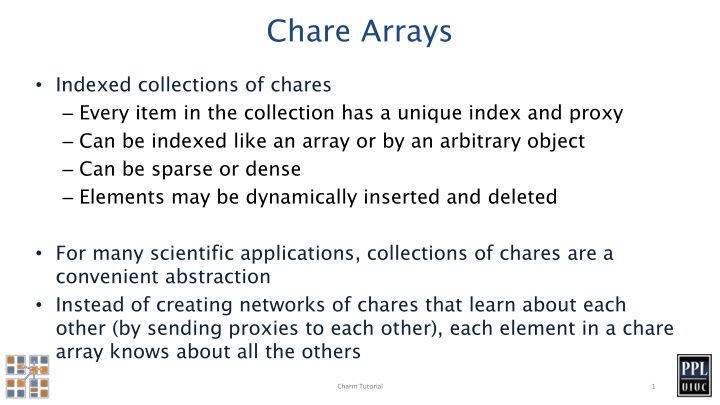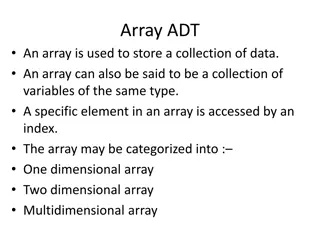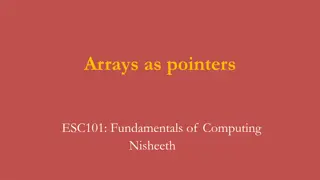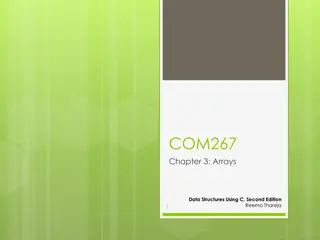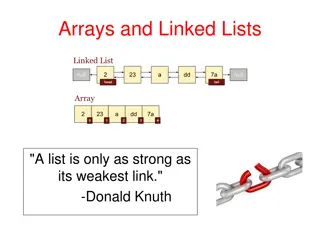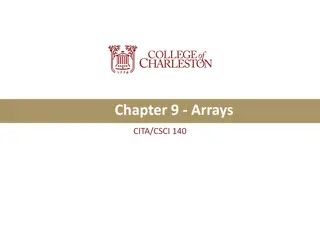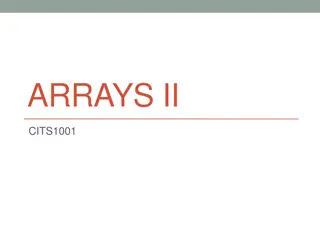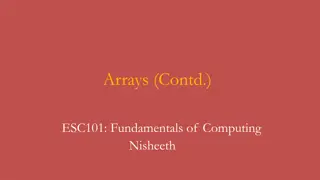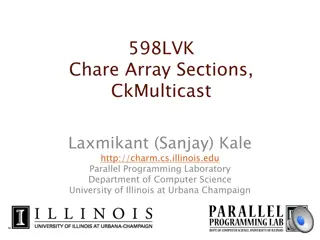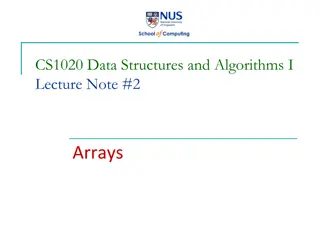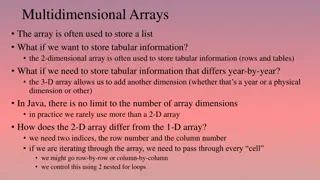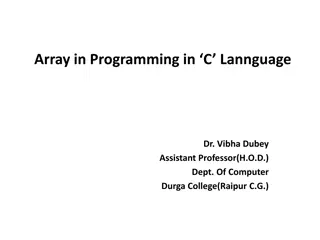Chare Arrays: Indexed Collections for Scientific Applications
Chare arrays are indexed collections of chares where each item has a unique index and proxy, enabling efficient indexing and dynamic insertion/deletion. This abstraction is widely used in scientific applications for its convenience. The arrays are distributed across processors by default and elements can be migrated for load balancing. Learn about declaring, constructing, and using chare arrays with this informative tutorial series.
Download Presentation

Please find below an Image/Link to download the presentation.
The content on the website is provided AS IS for your information and personal use only. It may not be sold, licensed, or shared on other websites without obtaining consent from the author.If you encounter any issues during the download, it is possible that the publisher has removed the file from their server.
You are allowed to download the files provided on this website for personal or commercial use, subject to the condition that they are used lawfully. All files are the property of their respective owners.
The content on the website is provided AS IS for your information and personal use only. It may not be sold, licensed, or shared on other websites without obtaining consent from the author.
E N D
Presentation Transcript
Chare Arrays Indexed collections of chares Every item in the collection has a unique index and proxy Can be indexed like an array or by an arbitrary object Can be sparse or dense Elements may be dynamically inserted and deleted For many scientific applications, collections of chares are a convenient abstraction Instead of creating networks of chares that learn about each other (by sending proxies to each other), each element in a chare array knows about all the others Charm Tutorial 1
Chare Array Location By default, chare arrays are distributed across the available processors (This is one possible initial assignment for 1D chare arrays) Chare array elements can be migrated by the user or the runtime (load balancing) Charm Tutorial 2
Declaring a Chare Array .ci file: array [1d] foo { entry foo(); // constructor // entry methods } array [2d] bar { entry bar(); // constructor // entry methods } .ci file: . .cpp struct foo : public CBase_foo { foo() { } foo(CkMigrateMessage ) { } // entry methods }; struct bar : public CBase_bar { bar() { } bar(CkMigrateMessage ) { } // entry methods }; cpp file: file: Charm Tutorial 3
Constructing a Chare Array Constructed much like a regular chare The size of each dimension is passed to the constructor at the end void someMethod() { CProxy_foo myFoo = CProxy_foo::ckNew(<params>, 10); // 1d, size 10 CProxy_bar myBar = CProxy_bar::ckNew(<params>, 5, 5); // 2d, size 5x5 } The proxy doesn t have to be retained: CProxy_foo::ckNew(10); The proxy represents the entire array, and may be indexed to obtain a proxy to an individual element in the array myFoo[4].invokeEntry( ); myBar(2,4).method3( ); Charm Tutorial 4
thisIndex 1d: thisIndex returns the index of the current chare array element 2d: thisIndex.x and thisIndex.y return the indices of the current chare array element .ci file: array [1d] foo { entry foo(); } CkPrintf( array index = %d , thisIndex); } }; .cpp file: struct foo : public CBase_foo { foo() { Charm Tutorial 5
Chare Array: Hello Example mainmodule arr { mainchare Main { entry Main(CkArgMsg ); } array [1D] hello { entry hello(int); entry void printHello(); } } Charm Tutorial 6
Chare Array: Hello Example #include arr.decl.h struct Main : CBase_Main { Main(CkArgMsg msg) { int arraySize = atoi(msg->argv[1]); CProxy_hello p = CProxy_hello::ckNew(arraySize, arraySize); p[0].printHello(); } }; struct hello : CBase_hello { int arraySize; hello(int n) : arraySize(n) { } void printHello() { CkPrintf( PE[%d]: hello from p[%d]\n , CkMyPe(), thisIndex); if (thisIndex == arraySize 1) CkExit(); else thisProxy[thisIndex + 1].printHello(); } }; #include arr.def.h Charm Tutorial 7
